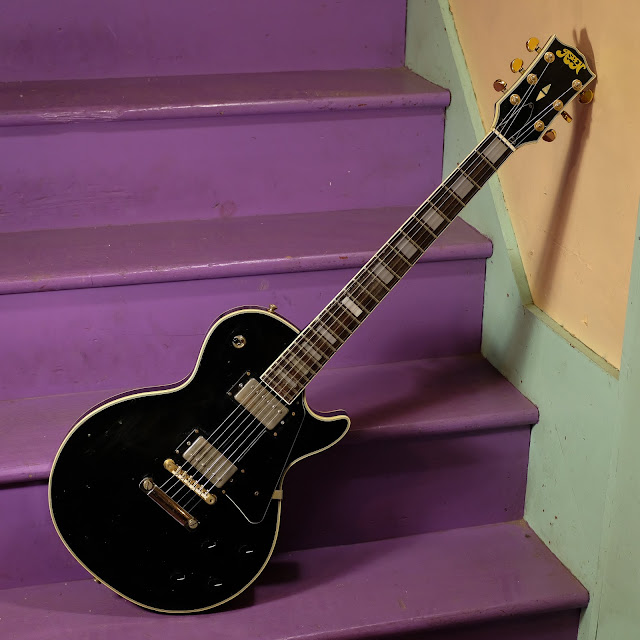1970s Aspen Les Paul Copy Electric Guitar
Well, it looks like a Les Paul, but with bolt-on neck, a much-routed thick ply body and a thin, arched (pressed/molded) ply top hovering over that body, it's not really much like a Les Paul, is it? This is one of scores of guitars wearing the "Aspen" brand and imported from Japan in the mid-'70s.
A friend of a friend owns this guitar and the friend of mine had me do it up for him. It was pretty savaged. The original wiring harness was mostly-missing and non-functional, the neck had a nice S-curve of warp in it, the original tuners were garbage, and the original pickups were only okay.
Work included: fret re-seating and level/dress, a new wiring harness with good components, swap-in of Orville by Gibson (Japanese, '80s) PAF-style humbuckers, a replacement tailpiece, parts-bin gold Grover Rotomatics from around the same time, general cleaning, and a good setup. This one was a struggle, but after all the work it sounds a bit like a cross between a Les Paul and an ES-175 -- sort-of -- and that's good in my book! Action was spot-on at 1/16" overall at the 12th fret and the neck was, for all intents and purposes, "straight" when I handed it back
The binding is outrageous and the actual-pearl blocks in the fretboard give it some upscale flair.
The Orville by Gibson pickups sound terrific. I added replacement mounting rings from my bins.
The bridge was installed in the wrong spot (and would be a huge pain to relocate), so I finagled almost-perfect intonation by swapping the direction of the saddles in their slots and reversing the direction the bridge was mounted. This let me get some of the break points are the far rear of the bridge.
While the minimalist knobs are not "correct" for a Les Paul, they do give it some individuality.
These old, heavy-duty Grover Rotomatics are a ton better than the original tuners.















Comments
It didn't have any strings, or nut, or tailpiece so I had to purchase it without first playing it. I wasn't about to string it up without first repairing the neck. I watched a few YouTube videos and did some online research before attempting it. When this was accomplished, I played the guitar unplugged I noticed the body resonates nicely. When I later took it all apart to work on the electronics I discovered that the top is not a carved top, but instead it is a pressed top like an ES-335 or similar. Large portions of the body are hollowed out, and if you tap on the top the guitar sounds hollow.
It had a Maxon and a Dimarzio pickup, and the electronics were completely custom and unusual, and corroded. The knobs wouldn't turn. The Maxon pickup had a lot of blue colored copper oxide on it, a bad sign. I guess it must have been left in a damp basement, thank goodness that the wood doesn't seem to have any water damage. I took it all out and put in new pickups and electronics.
So, this is a really cool guitar maybe from the late 70's or early 80's? There is absolutely no branding that I can see inside or outside. There is no serial number on the back of the headstock, which incidentally has the Gibson open book shape. Unlike most of the lawsuit era LP copies that I've seen this one has a set neck. It has original tuners from that era with the star graphic in black like I've seen on similar guitars.
Any ideas about how I can identify the manufacturer of this guitar. I'm sure it's not really worth anything except to me now that I've invested some time and money on it, but I would just love to know more about it. I wonder if this is also an Aspen model.